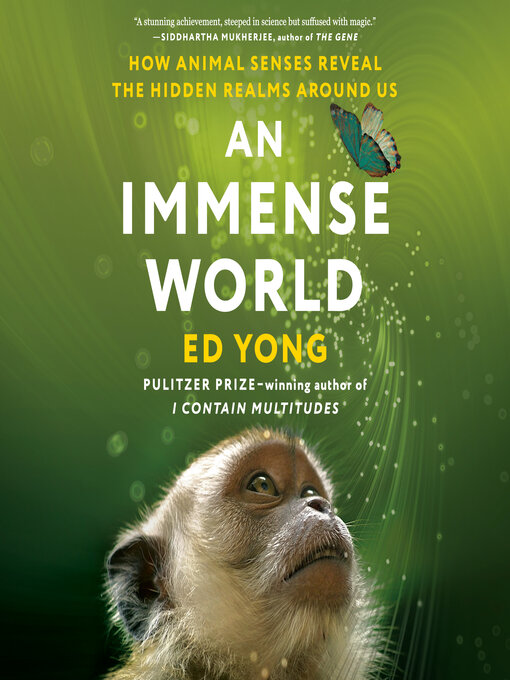- Popular titles
- 2025-26 Sunshine State Young Readers Award Gr. 6-8
- 2025-26 Florida Teen Reads
- See all ebooks collections

“One of this year’s finest works of narrative nonfiction.”—Oprah Daily
ONE OF THE TEN BEST BOOKS OF THE YEAR: The Wall Street Journal, The New York Times, Time, People, The Philadelphia Inquirer, Slate, Reader’s Digest, Chicago Public Library, Outside, Publishers Weekly, BookPage
ONE OF THE BEST BOOKS OF THE YEAR: Oprah Daily, The New Yorker, The Washington Post, The Guardian, The Economist, Smithsonian Magazine, Prospect (UK), Globe & Mail, Esquire, Mental Floss, Marginalian, She Reads, Kirkus Reviews, Library Journal
A KIRKUS REVIEWS BEST NONFICTION BOOK OF THE CENTURY
The Earth teems with sights and textures, sounds and vibrations, smells and tastes, electric and magnetic fields. But every kind of animal, including humans, is enclosed within its own unique sensory bubble, perceiving but a tiny sliver of our immense world.
In An Immense World, Ed Yong coaxes us beyond the confines of our own senses, allowing us to perceive the skeins of scent, waves of electromagnetism, and pulses of pressure that surround us. We encounter beetles that are drawn to fires, turtles that can track the Earth’s magnetic fields, fish that fill rivers with electrical messages, and even humans who wield sonar like bats. We discover that a crocodile’s scaly face is as sensitive as a lover’s fingertips, that the eyes of a giant squid evolved to see sparkling whales, that plants thrum with the inaudible songs of courting bugs, and that even simple scallops have complex vision. We learn what bees see in flowers, what songbirds hear in their tunes, and what dogs smell on the street. We listen to stories of pivotal discoveries in the field, while looking ahead at the many mysteries that remain unsolved.
Funny, rigorous, and suffused with the joy of discovery, An Immense World takes us on what Marcel Proust called “the only true voyage . . . not to visit strange lands, but to possess other eyes.”
WINNER OF THE ANDREW CARNEGIE MEDAL • FINALIST FOR THE KIRKUS PRIZE • FINALIST FOR THE NATIONAL BOOK CRITICS CIRCLE AWARD • LONGLISTED FOR THE PEN/E.O. WILSON AWARD
-
Creators
-
Publisher
-
Awards
-
Release date
June 21, 2022 -
Formats
-
OverDrive Listen audiobook
- ISBN: 9780593593554
- File size: 411785 KB
- Duration: 14:17:53
-
-
Languages
- English
-
Reviews

Loading
Why is availability limited?
×Availability can change throughout the month based on the library's budget. You can still place a hold on the title, and your hold will be automatically filled as soon as the title is available again.
The Kindle Book format for this title is not supported on:
×Read-along ebook
×The OverDrive Read format of this ebook has professional narration that plays while you read in your browser. Learn more here.